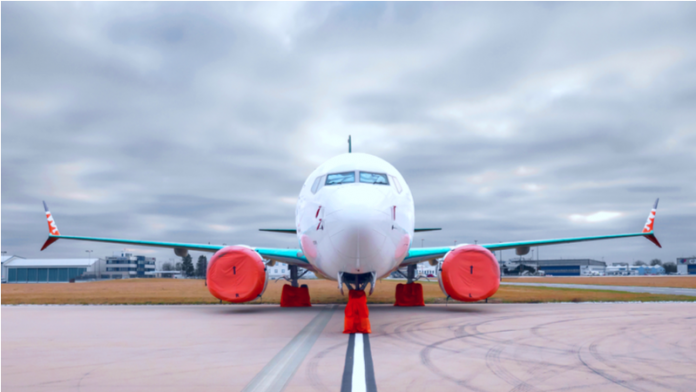Twenty months of development and safety scrutinization later, the Boeing 737 Max aircraft has received the necessary approvals to resume operations in select countries. Business Live Middle East’s Alvin Thomas writes.
* Business Live Middle East had reached out to The Boeing Company for a statement. The company did not revert at the time of publishing.
Three-hundred-and-forty-six people’s lives were lost and crowd confidence in an aviation pioneer was left in the blue when news of Boeing’s second fatal crash involving a 737 Max broke the news.
Boeing was criticized for the crashes – and the company’s development of the flight was thrust into the limelight.

Twenty months later, on Wednesday [December 2] the aircraft took to the skies again; this time for an exclusive media clique who experienced the re-engineered flight that was first grounded back in March 2019.
The United States and Brazil have since lifted their flight bans on the 737 Max, and American Airlines is expected to have the flight in the air after maintenance work (due to prolonged grounding) on 24 jets.
Meanwhile, Europe is expected to lift its restrictions on the flight by January 2021, according to the European Union Aviation Safety Agency (EASA).
Why was the Boeing 737 Max Grounded?

As per aviation statistics report website, Flight Radar, the Ethiopian Airlines and Lion Air flight crashes implicated the Maneuvering Characteristics Augmentation System (MCAS) – which is a flight control and anti-stall system that is unique to the 737 MAX.
As of December 2020, 790 aircraft have been grounded; though, some flights have been held back by Boeing, post-production.
Is the flight safe for passengers?

Business Live Middle East was able to procure a document issued on November 18 by the Federal Aviation Administration (FAA). The document states: “The FAA’s intent is to assure the global community that the 737 MAX is safe to operate and meets FAA certification standards.”
The report contains details of the FAA’s comprehensive review of the manufacturer’s proposed changes to the airplane’s Maneuvering Characteristics Augmentation System (MCAS).
The “thorough review” has reportedly taken more than 22 months and has included the full-time work of more than 40 engineers, inspectors, pilots, and technical support staff.
The effort also represents more than 60,000 FAA hours of review, certification testing, and evaluation of pertinent documents. This includes approximately 50 hours of FAA flight or simulator tests and FAA analysis of more than 4,000 hours of company flight and simulator testing.
In a video statement, FAA Administrator Steve Dickson said: “From the start of this process, we worked very closely with our foreign counterparts on every aspect of the return to service.
“We thoroughly evaluated the flight’s automated flight control system. We had published a ‘Proposed Air Worthiness Directives’ specifying design changes that must be made before the aircraft could return to commercial service.”
The senior administrator also stated that they evaluated over 500 public comments that they received on that proposal.
“Shortly after I became the FAA Administrator, I pledged to fly the Boeing 737 Max and promised that I wouldn’t unground it until I was 100 per cent comfortable that the aircraft is safe.
“In late September, I took the Max training that was recommended by the joint operations evaluation board, which included practicing the emergency procedures in the 737 Max simulator,” he added.
After that, he is known to have flown the aircraft himself for about two hours to evaluate its handling qualities and the functionality of the flight control system.
“From my personal experience, I can tell you now that I am 100 per cent comfortable with my family flying [in it].
But, he reiterates that this does not imply that the 737 Max will immediately return to the skies. “We will still have to approve the 737 Max pilot training program for every US airline operating the Max.”
‘We will never forget the lives lost’: Boeing CEO
Media statement from The Boeing Company

“We will never forget the lives lost in the two tragic accidents that led to the decision to suspend operations,” said David Calhoun, Chief Executive Officer of The Boeing Company.
“These events and the lessons we have learned as a result have reshaped our company and further focused our attention on our core values of safety, quality, and integrity.”
Throughout the past 20 months, Boeing has worked closely with airlines, providing them with detailed recommendations regarding long-term storage and ensuring that their input was a part of the effort to safely return the airplanes to service.
An Airworthiness Directive issued by the FAA spells out the requirements that must be met before U.S. carriers can resume service, including installing software enhancements, completing wire separation modifications, conducting pilot training and accomplishing thorough de-preservation activities that will ensure the airplanes are ready for service.
“The FAA’s directive is an important milestone,” said Stan Deal, president and chief executive officer of Boeing Commercial Airplanes. “We will continue to work with regulators around the world and our customers to return the airplane back into service worldwide.”
What components have changed in the Boeing 737 Max?
1) Boeing has reportedly updated their Flight Control Computer (FCC) software to eliminate MCAS reliance on a single AOA sensor signal by using both AOA sensor inputs and changing flight control laws to safeguard against MCAS activation due to a failed or erroneous AOA sensor
2) Flight control laws have now been changed to ensure that MCAS will not command repeated movements of the horizontal stabilizer. The revised flight control laws permit only one activation of MCAS per sensed high-AOA event. Any subsequent activation of MCAS would only be possible after the airplane returns to a low-AOA state.
3) Boeing changed flight control laws to include a limit for MCAS commands. The MCAS will stop commanding stabilizer movement at a point that preserves enough elevator movement for sufficient pilot control of aircraft pitch attitude for current operating conditions.
4) In addition to the software changes noted in Safety Items #1, #2, and #3, Boeing revised or added eight non-normal flight crew procedures to the Airplane Flight Manual and proposed additional training.
The flight crew procedures and the revised pilot training provide the pilot additional information to recognize and respond to erroneous stabilizer movement and the effects of potential AOA sensor failures.
5) Boeing has revised the AOA DISAGREE alert message implementation to achieve the original design intent to be standard on all 737 MAX aircraft.
6) Boeing implemented a cross FCC Trim Monitor, which can effectively detect and shut down erroneous stabilizer commands from the FCCs. This makes continued safe flight and landing for this type of failure not dependent on pilot reaction time.
7) The Collins Component Maintenance Manual (CMM) for the AOA sensor was revised to include a final independent check to ensure the repair has not introduced a bias.
To ensure that each airplane’s two AOA sensors are functioning properly upon return to service, operators must perform AOA Sensor System Tests on each airplane prior to its return to service. This test uses a fixture to position the AOA vane and verify that the reading provided by each AOA sensor is accurate.
Why is the 737 Max important to the GCC’s aviation sector?
Over 4,912 flights have been ordered in total globally, and 387 airframes have been delivered to airlines and operators since 2014. Some 400 more have been built but have been placed in storage.
Oman Air, the Sultanate’s flagship carrier, has five aircraft in its fleet and is due to receive 25 more from the American aviation company.
The flight has also been deemed a “workhorse” in the aviation industry, due to its reduced fuel usage and lower CO2 emissions. The Max 8 reportedly uses “Eight per cent less fuel per seat” than the competitor Airbus A320neo; albeit, the latter can be had in multiple engine options – a PurePower PW1100G-JM from Pratt and Whitney, and the LEAP-1A from CFM International.

The 737 Max reportedly offers 14 per cent lower CO2 emissions than the brand’s latest Next-Generation (NG) 737 and 20 percent lower emissions than the first Next-Generation 737s.
A report published by Boeing’s 2020 Commercial Market Outlook (CMO) projects that the Middle East region will require nearly 3,000 new airplanes valued at US$685 billion to support demand through 2039.
Middle East passenger traffic growth too is projected to grow by 4.3 per cent per year, which is 4 per cent above the global average. Meanwhile, long-term demand for commercial services is worth US$725 billion.
The final complete report from @TransportDems on the 737 Max, accompanying documents, transcripts and records have all been uploaded for review here. https://t.co/7gtEQp5NeP
— Jon Ostrower (@jonostrower) September 16, 2020
Source: BBC, CNN, FAA, Boeing, Oman Air






